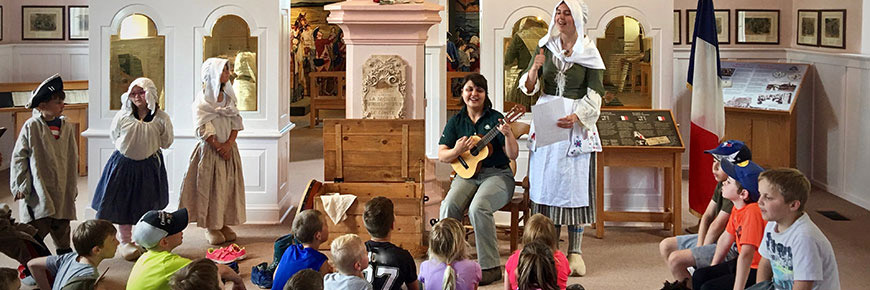
School programs
Grand-Pré National Historic Site
Grand-Pré National Historic Site of Canada provides visitors with the expertise of interpretive guides to enhance their experience. The Visitor Centre features a spacious exhibit hall dedicated to the history of Grand-Pré and Acadie. Visitors can immerse themselves in the story of the Deportation through an engaging multimedia theatre presentation.
The site also offers a variety of educational activities and workshops tailored for school groups, ranging from primary to grade 12. Programs such as Spoons and Tunes, Mixed up Artifacts, and The Deportation Activity are designed to engage students in interactive learning. Each activity lasts approximately 30 minutes.
To ensure availability, it is important to reserve for these programs. Reservations can be made by phone or email (grandpre@pc.gc.ca). Please provide the following details, and note, our maximum capacity is 90 students per day:
- Name of School
- Date of Arrival
- Arrival/Departure Time
- Number of Students
- Grade Level
- Number of Teachers/Chaperones
- Choice of Activity (see links, below)
- Contact Name, Email, and Phone Number
Overview of Activities by Grade Level
*The following is a guideline and most programs can be adapted to various grade levels
All ages
"Spoons and tunes" (Guided Activity)
Indoor or outdoor (weather permitting)
Join us for Spoons and Tunes, a fun, interactive activity where you’ll explore traditional Acadian music and dance while learning about 18th-century culture.
What to expect:
- Play Spoons: Try out this classic Acadian instrument.
- Learn Dance Steps: Groove to a basic Acadian dance.
- Explore History: Discover how music and dance reflected Acadian life in the 18th century.
This hands-on experience makes history come alive through music, movement, and fun!
Grades 2 to 4
"My Visit to Grand-Pré" (Self-Guided Activity)
Indoor and outdoor activity
This activity is done in small groups whereby students observe and explore Grand-Pré National Historic Site in search for anwers to the questions posed in the “My Visit to Grand-Pré” questionaire.
Grades 4 to 9
"Mixed up artifacts" (Guided Activity)
Indoor activity
Imagine life in 17th and 18th Century Acadia through its artefacts. Objects made by humans represent a complete gamut of activities. Among them, the most fundamental are linked to our essential needs: eating, drinking, and protecting ourselves from the elements. Even without written documentation, objects can speak eloquently about their users. Students will help uncover the past using the systematic approach of the archaeologist, practicing focused observation, classification, and comparison in a team approach context.
Grades 5 to 10
"Discover Grand-Pré" (Self-Guided Activity)
Indoor and outdoor activity
This activity is done in small groups whereby students observe and explore Grand-Pré National Historic Site in search for anwers to the questions posed in the “Discover Grand-Pré” document.
Grades 5 to 8
"Detective at Grand-Pré" (Self-Guided Activity)
Indoor and outdoor activity
This activity is done in small groups whereby students observe and explore various aspects of Acadian history that will enable them to answer the questions posed on the “Discover Grand-Pré” questionaire.
Grades 7 to 12
"At Grand-Pré, Paintings, Sculptures, and Art Speak to You" (Self-Guided Activity)
Indoor and outdoor activity
This activity is done in small groups whereby students observe and explore various aspects of Acadian life and culture enabling them to answer the questions posed on the “Discover Grand-Pré” questionaire.
Grades 7 to 12
"Deportation: 1755" (Guided Activity)
Indoor activity
It is normally preceded by the viewing of the multimedia presentation (22 min). The goal of this activity is to provide students with a more personal comprehension of the events of the 1755 Deportation. This is accomplished by each student taking on the role of an Acadian who actually lived in Grand Pré at the time, and working through the events; from being called to the church where the Order was read out, to their arrival in the colonies.
- Date modified :